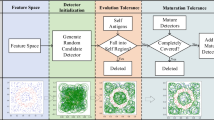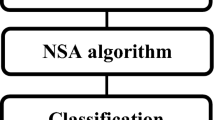Abstract
Anomaly detection algorithms inspired by the natural immune system often use the negative selection metaphor to implement non-self detection. Much research has gone into ways of generating good sets of non-self detectors or antibodies and these methods’ time and space complexities. In this paper, the antibody morphology is defined as the collection of properties defining the shape, data-representation and data-ordering of an antibody. The effect these properties can have on self/non-self classification capabilities is investigated. First, a data-representation using fuzzy set theory is introduced. A comparison is made between the classification performance using fuzzy and m-ary data-representations using some benchmark machine learning data-sets from the UCI archive. The effects of an antigen data reordering mechanism based on Major Histocompatibility Complex (MHC) molecules is investigated. The population level effect this mechanism can have by reducing the number of holes in the antigen space is discussed and the importance of data order in the r-contiguous symbol match-rule is highlighted. Both are analysed quantitatively using some UCI data-sets.
Access this chapter
Tax calculation will be finalised at checkout
Purchases are for personal use only
Preview
Unable to display preview. Download preview PDF.
Similar content being viewed by others
References
Ayara, M., Timmis, J., de Lemos, R., de Castro, L., Duncan, R.: Negative Selection: How to Generate Detectors. In: Proceedings of the 1st International Conference on Artificial Immune Systems (ICARIS), pp. 89–98 (2002)
Blake, C.L., Merz, C.J.: UCI Repository of machine learning databases,Irvine, CA: University of California, Department of Information and Computer Science (1998), http://www.ics.uci.edu/mlearn/MLRepositoryhtml
Canham, R.O., Tyrrell, A.M.: A Multilayered Immune System for Hardware Fault Tolerance within an Embryonic Array. In: Proceedings of the 1st International Conference on Artificial Immune Systems (ICARIS), pp. 3–11 (2002)
D’haeseleer, P., Forrest, S., Helman, P.: An immunological approach to change detection: Algorithms, analysis and implications. In: Proceedings of the 1996 IEEE Symposium on Research in Security and Privacy, pp. 110–119. IEEE Computer Society Press, Piscataway (1996)
Diao, Y., Passino, M.: Immunity-Based Hybrid Learning Methods for Structure and Parameter Adjustment. IEEE Transactions on Systems, Man and Machine (July 2000)
Dittrich, P., Ziegler, J., Banzhaf, W.: Artificial Chemistries - A Review. Artificial Life VII 3, 225–275 (2001)
Forrest, S., Perelson, A.S., Allen, L., Cherukuri, R.: Self-nonself discrimination in a computer. In: Proceedings of the 1994 IEEE Symposium on Research in Security and Privacy, Los Alamitos, CA, IEEE Computing Society Press, Los Alamitos (1994)
Frederick, Z.: A Comprehensive Case Study: An Examination of Machine Learning and Connectionist Algorithms, Masters Thesis, Brigham Young University (1995)
Helman, P., Forrest, S.: An efficient algorithm for generating random antibody strings, Technical Report CS-94-07, The University of New Mexico, Albuquerque, NM (1994)
Hightower, R.R., Forrest, S., Perelson, A.S.: The Evolution of Emergent Organization in Immune System Gene Libraries. In: Eshelman, L.J. (ed.) Proc. of the 6th Int. Conference on Genetic Algorithms, pp. 344–350. Morgan Kaufmann, San Francisco (1995)
Hofmeyr, S.A.: An Immunological Model of Distributed Detection and its Application to Computer Security, Ph.D. Thesis, University of New Mexico (May 1999)
Kim, J., Bentley, P.: An Artificial Immune Model for Network Intrusion Detection. In: Proceedings of the 7th European Congress on Intelligent Techniques - Soft Computing (EUFIT 1999), Aachen, Germany, September 13-19 (1999)
Nasraoui, O., González, F., Dasgupta, D.: The Fuzzy Artificial Immune System: Motivations, Basic Concepts, and Application to Clustering and Web Profiling. In: IEEE International Conference on Fuzzy Systems, Hawaii, HI, May 13, pp. 711–716. IEEE, Los Alamitos (2002)
Oprea, M., Forrest, S.: Simulated Evolution of Antibody Gene Libraries under Pathogen Selection. In: Proc. of the IEEE conference on Systems, Man and Cybernetics (1998)
Parham, P.: The Immune System. Garland Publishing/Elsevier Science (2000)
Perelson, A.S., Hightower, R., Forrest, S.: Evolution and Somatic Learning in V-Region Genes. Research in Immunology 147, 202–208 (1996)
Pfeifer, U., Poersch, T., Fuhr, N.: Searching proper names in databases. In: Proceedings of HIM 1995: Hypertext-Information Retrieval and Multimedia, Konstanz, Germany, pp. 259–275. Universitatsverlag Konstanz (1995)
Sasaki, N., Dote, Y.: Diagnosis and Control for Multi-Agent Systems using Immune Networks. Artificial Neural Networks in Engineering (ANNIE 2002) (November 2002)
Singh, S.: Anomaly Detection Using Negative Selection Based on the r-contiguous Matching Rule. In: Proceedings of the 1st International Conference on Artificial Immune Systems (ICARIS), pp. 99–106 (2002)
Zadeh, L.: Fuzzy sets. Inf. Control 8, 338–353 (1965)
Author information
Authors and Affiliations
Editor information
Editors and Affiliations
Rights and permissions
Copyright information
© 2003 Springer-Verlag Berlin Heidelberg
About this paper
Cite this paper
Kaers, J., Wheeler, R., Verrelst, H. (2003). The Effect of Antibody Morphology on Non-self Detection. In: Timmis, J., Bentley, P.J., Hart, E. (eds) Artificial Immune Systems. ICARIS 2003. Lecture Notes in Computer Science, vol 2787. Springer, Berlin, Heidelberg. https://doi.org/10.1007/978-3-540-45192-1_27
Download citation
DOI: https://doi.org/10.1007/978-3-540-45192-1_27
Publisher Name: Springer, Berlin, Heidelberg
Print ISBN: 978-3-540-40766-9
Online ISBN: 978-3-540-45192-1
eBook Packages: Springer Book Archive




